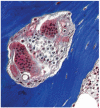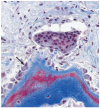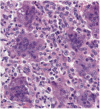Giant osteoclasts after long-term bisphosphonate therapy: diagnostic challenges
- PMID: 19491914
- PMCID: PMC2860596
- DOI: 10.1038/nrrheum.2009.87
Giant osteoclasts after long-term bisphosphonate therapy: diagnostic challenges
Abstract
Background: A 55-year-old woman with a 5-year history of osteoporosis treated for 4 years with an oral aminobisphosphonate presented with a recent vertebral fracture. A bone biopsy specimen revealed giant osteoclasts with more than 40 nuclear profiles.
Investigations: Bone mineral density determinations, measurement of serum 25-hydroxyvitamin D, intact parathyroid hormone, calcium, inorganic phosphorus, alkaline phosphatase and creatinine levels, urinary excretion levels of the N-telopeptide of type 1 collagen, and bone biopsy. Examination of the patient and review of the bone specimen.
Diagnosis: Giant osteoclasts after long-term bisphosphonate use, without evidence of malignancy.
Management: Interpretation of the bone biopsy specimen listed several bone disorders. The bone specimen was reviewed and the histological differential diagnosis was carefully considered. The giant osteoclasts were detached from bone and frequently apoptotic in a normal marrow stroma, with low-to-normal amounts of osteoid and osteoblasts. These features are typical of giant osteoclast formation after long-term aminobisphosphonate therapy. the patient was reassured that the bone findings were unlikely to be detrimental. Aminobisphosphonate treatment was reinstituted, and 1 year later the patient was asymptomatic.
Figures





References
-
- Liberman U, et al. Effect of oral alendronate on bone mineral density and the incidence of fractures in postmenopausal osteoporosis. N. Engl. J. Med. 1995;333:1437–1443. - PubMed
-
- Bone HG, et al. Dose-response relationships for alendronate treatment in osteoporotic elderly women. J. Clin. Endocrinol. Metab. 1997;82:265–274. - PubMed
-
- McClung M, et al. Alendronate prevents postmenopausal bone loss in women without osteoporosis. Ann. Intern. Med. 1998;128:253–261. - PubMed
-
- Reid IR, et al. Alendronate in Paget’s Disease. Am. J. Med. 1996;101:341–348. - PubMed
-
- Saag KG, et al. Glucocorticoid-Induced Osteoporosis Intervention Study Group Alendronate for the prevention and treatment of glucocorticoid-induced osteoporosis. N. Engl. J. Med. 1998;339:292–299. - PubMed
Publication types
MeSH terms
Substances
Grants and funding
LinkOut - more resources
Full Text Sources
Medical

